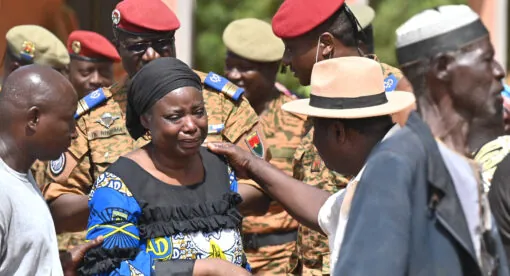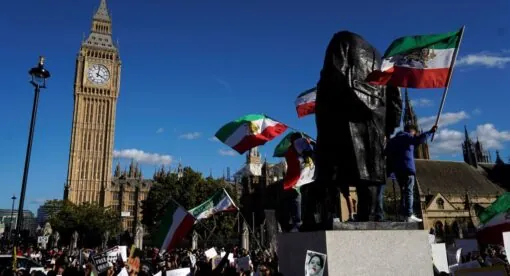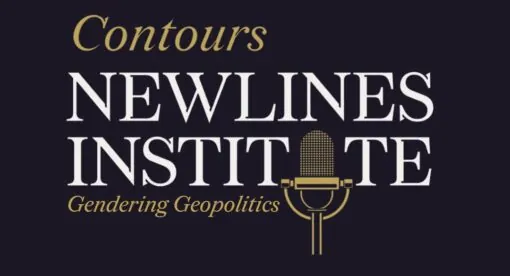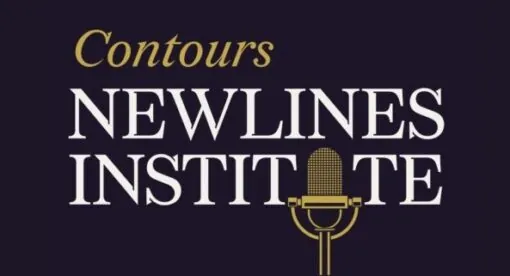On this episode of Contours, Power Vacuums Program Head Caroline Rose sits down with New Lines Non-Resident Senior Fellow and former spokesman for Operation Inherent Resolve, Col. Myles B. Caggins III, to discuss the lingering effects of U.S. base transfers, personnel reductions, and transition to an advise-and-assist role in Iraq.
Caroline Rose:
Hello, and thank you for joining us for a new episode of Contours, a podcast series of the New Lines Institute for Strategy and Policy. Today, we’re sitting down with one of our newest members of the New Lines Institute, non-resident senior fellow Colonel Myles B. Caggins III, to discuss how the role and posture of the international coalition in Iraq has evolved, and where, amidst a series of political and security challenges in the country, this could be headed.
Colonel Caggins is a colonel in the US Army and a non-resident senior fellow at the New Lines Institute. From military posts, combat zones, inside the Pentagon, and the White House National Security Council, he’s led communication strategy for some of the most challenging issues of the past decade, including America’s rebalance to Asia and policy towards North Korea and China, Guantanamo and enemy combatant detention, the mission to defeat ISIS, military human capital in recruiting, and nuclear security.
Most recently, he served as the US Army’s visiting fellow at the Council on Foreign Relations in New York. He served three year-long combat tours in Iraq and served as the spokesman for the Global Coalition to defeat ISIS in Iraq and Syria, where he led a multinational communication team representing 78 nations and witnessed the initial drawdown efforts in Iraq during the later months of 2020.
Colonel Caggins, it is wonderful to have you here with us today. Thank you so much for joining us. After the American withdrawal from Afghanistan, there were many questions about what constitutes a responsible withdrawal – one that accounts for local partners’ operational capacity and seeks to prevent any emergence of a power vacuum in its wake. Some fears arose over the fate of Iraq, where roughly 2,500 American personnel remain serving in a strict advise and assist mission to bolster the capacity and the effectiveness of its local partners, the Iraqi Security Forces and the Kurdish Peshmerga.
The mission – the Combined Joint Task Force Operation Inherent Resolve – has evolved immensely over the last two years alone. After tensions erupted over the killing of Iranian IRGC Commander Qasem Soleimani, the Department of Defense directed the US transfer of eight bases and narrowed its presence by over 2,700 personnel, largely consolidating its posture to Erbil and Baghdad.
I want to start off and reflect on your time serving as a spokesman for the Global Coalition to defeat ISIS in Iraq and Syria, where you were a part of this fast-paced initiative to narrow down the United States posture in Iraq. What was that like for you? And did you see Iran’s Operation Martyr Soleimani strikes as an event that tipped the scales and served as a wake-up call for partial withdrawal?
Myles B. Caggins:
Caroline, it’s great to be talking to you as your colleague at the New Lines Institute. As we continue to hear some of the experiences that happened on the ground in Iraq and Syria during the time I was there, from August 2019 until September 2020. As you said, I was the spokesman for the Global Coalition to defeat ISIS. The military component of that, led by United States Army Lieutenant General, a three-star General from the headquarters of the Third Corps deployed out of Fort Hood, Texas.
Well, let’s be very clear, the organization, the Combined Joint Task Force Operation Inherent Resolve, is what we call joint. It included Army, Navy, Air Force, Marines, and multinational. In fact, we had probably around 26 nations that were participating with staff officers or military operational units between our headquarters in Kuwait, Iraq, and Syria. While we were there, focused on the mission to defeat ISIS, there were other things that were going on.
Tensions were rising between the United States and Iran, particularly based on activity conducted by Kata’ib Hezbollah and other Iranian-backed Shia militia groups. Now, I want to make a distinction. When ISIS swept across Syria and Iraq in 2013 and 2014, there was a rally for militias in Iraq called the Hashd al-Sha’bi. Most of them, but not all of them, were aligned with Shia Islam, and they fought valiantly alongside Iraqi army, alongside Peshmerga, to liberate great cities like Mosul and other cities and towns captured by ISIS.
Some of these militia groups, though, are rogue militia groups. They operate outside of the laws of Iraq and do not respond properly to the Iraqi Ministry of Defense. Among them is Kata’ib Hezbollah, and Kata’ib Hezbollah has spread terrorism across the Middle East, from Iran all the way through Lebanon and Syria. So, tensions were rising, and just before the new year, in late December 2019, Kata’ib Hezbollah attacked the US Embassy in Baghdad, and as a result of that attack and some back-and-forth rocket attacks that killed an American linguist in Kirkuk, and what we called, from CENTCOM, defensive retaliatory strikes, defensive strikes, this led to a mission to kill Qasem Soleimani.
During this time period of increased tensions, and even before the killing of Qasem Soleimani, the Commander of the CJTFOIR, Lieutenant General Pat White, had worked with the operational planning team and the future operations team for a plan to start drawing down forces. And we were drawing down forces because of the success against ISIS. Even before the heightened tensions and the killing of Qasem Soleimani, US Army Lieutenant General Pat White had already directed the coalition military planning staff to come up with a plan to start drawing down forces in Iraq. This drawdown was planned because at the stage of the campaign where we were, in fall 2019, Iraq and Syria had been liberated from any ISIS control of physical territory, and frankly, we didn’t need to have as many advisors and trainers in the region anymore, since the kinetic operations of battles had gone away.
But things accelerated for two primary factors. One, these tensions, after the killing of Qasem Soleimani, there was the theater ballistic missile strike on Al Asad base in the Anbar province of Iraq, west of Baghdad, and a strike in Iraqi Kurdistan, near Erbil. And General White thought, “You know what? It doesn’t make any sense to have troops out here in harm’s way if they’re no longer needed for a mission that has been largely accomplished in the campaign that has evolved.” Shortly following, we had a pandemic. Coronavirus 19 came about, and this was another reason to remove some of our troops, close down some of the bases where we were partnered with Iraqi and Peshmerga, because training came to a full halt.
As your listeners can imagine, military training is a contact sport. You have to have sergeants talking to trainees and officers talking to sergeants. And hands-on training for weapons and physical fitness. None of those things were happening in the spring and summer of 2020 as the world was grappling with the coronavirus, and this is a full 12 months before vaccinations were widespread. So, General White prioritized further reduction of troops, and as a result of that, we, in about a 90-day period, departed eight different bases inside Iraq.
Caroline Rose:
Thank you so much, Colonel Caggins, for explaining the rationale behind this partial withdrawal and all these base transfers. Some have rung alarm bells about how some of these bases were concentrated in key areas where townships, infrastructural systems, roadways, and patrols under Iran-aligned militias, such as Kata’ib Hezbollah. How did the withdrawal process account for these vulnerabilities and these risk matrices?
Myles B. Caggins:
Yeah, let me describe for your listeners the array of coalition and US troops in early 2020 from Baghdad. That was the location where we had the headquarters of the coalition, and all the coalition troops are inside Iraqi bases – compounds within a larger base. We also have a facility called the Baghdad Diplomatic Support Center, and that is a State Department-led facility with a lot of military on it, including special operations. Moving to the west, we had a base at Taqaddum, where we had Marines there who were advising Iraqi Army. Further west in the Anbar Province, down the Euphrates River, you had Al Asad base – very large base where we have a lot of Army and Air Force components, and trainers from multiple nations, including Denmark, and other forces from the Netherlands, as well as Australia.
Then, just north of Baghdad, you have Taji base – very large base with multinational trainers there: Brits, French, Americans, Italians. And up in Mosul, we had a small compound inside the city of Mosul where there’s significant coordination in 2016 and 2017 for airstrikes in the Battle of Mosul. And nearby there, there was the Qayyarah West Airfield near the oil fields, that’s southeast of Mosul, and some other smaller bases too. Camp Swift is one of them, and then over in Kirkuk we had the K-1 base where, again, you had trainers, advisors and special operations. And in Iraqi Kurdistan region we have a large contingent of troops in Erbil, at the Erbil Air base, and a couple of other smaller bases there. Now, these bases were established when there was a training and advising mission for operations against ISIS.
I mentioned earlier about the presence of these Shia-backed militia groups, and one place that I didn’t mention in my overview is Al-Qa’im. Al-Qa’im is on the western border of Iraq and Syria, and just on the Syria side of Al-Qa’im is a Syrian town called Abu Kamal. Kata’ib Hezbollah, also known as Brigade number 45, operates in and around Al-Qa’im. In fact, the militia groups had a border crossing that was parallel or nearby the formal government of Iraq border crossing, where they would ship lethal aid and logistics right through the border without being contested by the Iraqi government. And also, in different places, you have militia groups who are collecting illegal taxes, taxes on commerce, and that’s what happens when you have rogue organizations that are heavily armed.
But let’s be very clear, the mission of the coalition is to defeat ISIS. This is not a mission that France, the UK, Singapore and South Korea signed up for to take on Iran and Iranian-backed militia groups. So, the decisions to move out of these places was made jointly, with the government of Iraq. Each time a base was transferred, there were millions of dollars of equipment transferred from the governments of the United States or Canada, or other appropriate nations to the government of Iraq. There is a office of what’s called Receivership that would do joint inventories with the coalition troops and sign legal documents acknowledging the list of the equipment and how much that equipment was worth.
Each one of these transfer ceremonies was attended by US generals and Iraqi generals, and was covered by the media. This was a deliberate withdrawal and downsizing of our presence in the country that was made as part of an agreement between leaders and Baghdad.
Caroline Rose:
I want to talk a bit about some of the effects on operational capacity with the Iraqi security forces. Initially, with the base transfer announcements, and then later, in December 2021, a transition in the mission from a combat role to a strict advise and assist role, there were some concerns raised about the Iraqi security forces’ posture and lessened operational capacity. Around that time, a Congressional Quarterly report stated that the ISF struggled to find a fixed target and were suffering from procurement and maintenance problems that could leave them vulnerable.
However, since then, there’s been evidence that the ISF has been working to lessen dependence on US assistance and boost their own operational capacity. A lead inspector general for Operation Inherent Resolve quarterly report to the United States Congress last November noted that out of 426 anti-ISIS group operations carried out by Iraqi security forces between July and September, only 13 involved a partnership with coalition forces. Now, do you think that Iraqi forces are on the right path towards improving their own operational capacity? And how do you think the United States can assist in this effort?
Myles B. Caggins:
It’s important to recognize that the Iraqi security forces, who’ve been partnered with the United States really as far back as 2003, have been trained and advised, mentored and equipped for internal security. But we know from the collapse of those forces in Mosul when ISIS took over in 2014, that leadership is important and that those forces do not have rampant corruption. In recent months, though, with the huge wake-up call from ISIS, the Iraqi security forces, including the Army, the federal police, the border guards, more elite groups like the Falcons Brigade and the vaunted Counter-Terrorism Service, have conducted their own raids against ISIS with limited support from coalition advisors. In fact, the end of what’s called advise, assist, and accompany raids happened in the spring of 2020 when two Marine Raiders were killed on operations in the north-central part of Iraq against a small ISIS stronghold in the Makhmur Mountains.
What the coalition does now is operational-level advising. At the headquarters in Baghdad, or your listeners, imagine a room that has theater-style seating, like a movie theater, big screens in the front that have maps or images of drones flying over, with coalition advisors from at least 10 nations sitting side by side with Iraqi colonels and generals and other officers doing operational planning advising. There still is the occasional airstrike that’s conducted, and, absolutely, there’s information sharing, and what the coalition does now is helps the Iraqi security forces have extra reach and a tactical overmatch against ISIS.
Imagine ISIS with binoculars, protecting their caves or their small desert hideouts, and overhead there are drones that have high-definition television that’s feeding information back to intelligence and targeting cells, and then that’s shared with Iraqi commandos on the ground so they can do raids. That’s where we are now, and that’s where we should be in the state of the campaign, and as the Defense Department’s Inspector General Report showed, there’s little day-to-day direct assistance provided for the security operations against ISIS that the Iraqi security forces and the Peshmerga are successfully conducting all the time.
Caroline Rose:
I want to shift gears to focus a bit on Iraq’s political landscape, which, of course, has become incredibly complicated and precarious in the last few months, with a new government elected after over a year of deadlock. With the rise of pro-Iran Shia coordination framework, now the largest bloc since Sadr’s withdrawal, and the likelihood of the new Prime Minister, Mohammed Shia’ Al Sudani, to forge cozier ties with Iran than his predecessor. With this changing landscape in mind, what do you think the primary challenges will be for coalition forces and the advise and assist mission in Iraq?
Myles B. Caggins:
We are all watching closely the new Prime Minister, particularly some of his appointments that he’s made. The previous Prime Minister, Prime Minister Kadhimi, had a very strong relationship with Americans and coalition forces, and he had strong personal ties from his background of working with US troops for years and as a member of the media. So, we have a new Prime Minister, Prime Minister Al-Sudani, and he’s made some initial appointments that are of some cabinet-level leaders who have strong ties to Iran.
Now, Iran and Iraq will forever have economic ties and cultural ties, and it’s just not rational for people in Washington or other Western capitals to think that there would be some divorce between Iran and Iraq. That being said, it’s important that there’s continued communication, and that communication happens in a diplomatic way through the embassy in Baghdad, and also from military to military, through the Office of Security Cooperation. That’s a State Department endeavor that conducts foreign military sales, military exchanges, as well as CJTFOIR, for advising and assisting against ISIS. That type of relationship needs to continue. And also being mindful that there are malign actors and aggressive militia groups who, at any point, can strike the Iraqi bases that have US troops.
Caroline Rose:
This past March, the outgoing commander of Central Command, General Frank McKenzie, stated that any force level adjustment in Iraq would be made in close close consultation with the government of Iraq and, of course, their NATO counterparts, something that would hopefully achieve normalized security cooperation in an agreement with Iraq. In his end of tour interview in September 2020, Lieutenant General Pat White also remarked that what would allow the United States to normalize was a partner force that could, “Get out there and get after it by themselves and that they can sustain operations over time, maintaining a tactical overmatch against the adversary.”
What do you think is the ideal arrangement and posture in Iraq for the United States? Do you think that that would involve a formal and continued advise and assist mission, with the training of local forces, advising military leadership, and the provision of weapons?
Myles B. Caggins:
The US and Iraq have a strong bilateral relationship, and there have been dialogues between the two nations, intentional dialogues, for the past couple of years. One of the aspects of those discussions is the security partnership. Those dialogues also include economic ties, cultural arrangements, and aspects of trade. But focusing on security, this is a relationship that will continue, and the US troops are invited by the government of Iraq. Frankly, the Iraqis know that having the US there is a boon for their military and a boon for their economy. At this point, the US has contributed more than $7 billion in assistance to Iraq since 2014, with the onset of the operations against ISIS. The US continues to provide weapons, other military equipment to the Iraqi Peshmerga in Kurdistan, as well as the broader Iraqi security forces.
But we’ve moved away from the basic training of troops. There’s not days now where you have coalition advisors who are teaching soldiers how to shoot their rifles and conduct land navigation or basic first aid, those things the Iraqis are teaching themselves. What we are providing now is high-level specialized advice and assistance for what General White mentioned, as to provide tactical overmatch. And the Iraqis have to want it for themselves. And they’ve demonstrated that they do, particularly against ISIS.
But one area that we are still doing a little bit more direct advice and training is special operations. We have coalition commandos who are located at a training center with Iraqi commandos, and also we have coalition commandos who are in Iraqi Kurdistan region with a couple of different types of commandos, special operations groups. And those elite forces can go on raids against high-value terrorists, against really bad guys, or very sensitive missions, and they’re going to conduct them at night. They have the best training, the best equipment, and they’re quite capable, and that is how they’re able to continue to kill and capture leaders of ISIS and terrorist groups. That type of partnership has been successful for many years, and it should continue to keep success and stability and peace throughout the region.
Let’s also remember that we can’t separate Iraq and Syria from each other because their borders are aligned, and ISIS doesn’t respect those borders anyway. There’s a cooperation under the remit of the broader coalition where information is shared across the national borders with the troops in Iraq and as well as the American partners in Syria, the Syrian Democratic Forces.
And the Syrian Democratic Forces have their own commandos, the Hassan Anti-Terror units and Yekîneyên Anti-Terror units. Those units are trained and advised by US special operations. So, that special operations partnership, the intelligence sharing, and the high-level operational advice that’s happening in Baghdad and Erbil should continue, as ISIS remains a threat, and ISIS still has designs on taking back territory and causing disruption and destruction inside Iraq.
Caroline Rose:
Thank you, Colonel Caggins, for this dynamic discussion on drawdown efforts within the US-led Operation Inherent Resolve Mission in Iraq.
And thank you to our listeners for chiming in. Please make sure to subscribe to our podcast series Contours on our streaming platforms, including iTunes, SoundCloud, and Spotify so you don’t miss any of our new podcasts. Check out further analyses about geopolitics and foreign policy at www.newlinesinstitute.org.







